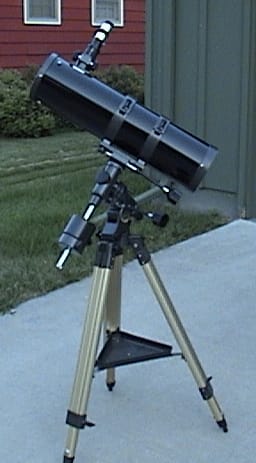Orion telescope
In the summer of 2001 I acquired a 6-inch Orion Skyview Deluxe telescope.
This is a completely manual telescope with a focal length of 750mm. It comes with a German equatorial mount, which is my favorite mount for a manual telescope, because if you take the time to align it with the celestial pole, you can track most objects as they move by simply turning the right ascension knob.
This telescope is no longer sold, and has been replaced by the SkyView Pro, which has a better mount and may be a better scope.
The Skyview Deluxe isn’t a top of the line scope, but my logic was that Orion sells you quite a bit of aperture for the money and I wasn’t sure if I’d stay with stargazing or give it up after six months. As it happens, I enjoyed my scope quite a bit and wished I’d splurged and bought the 8-inch version.
The Skyview Deluxe is a manual scope and has fairly sensitive Right Ascension and Declination controls. It was an excellent scope for me to use to learn the night sky again and learn how to star hop. The F/5 focal ratio means that you can’t practically magnify very high (150x has been my usual limit) but by the same token you see quite a bit of sky, with a low power of around 25x. It is what they call a “rich field” telescope.

This scope is quite good for observing large, bright deep sky objects such as open clusters. I can go as low as 23x without seeing the central obstruction and with a 32mm Celestron Plossl eyepiece I can see the entire Pleiades in my eyepiece. I like that.
To the left is a picture of my normal field setup, minus the Telrad finder, which was on my Celestron scope. The Telrad comes with a base that attaches to the scope. If you have multiple bases, you can move your Telrad finder easily from scope to scope.
I learned to star-hop with this scope and how to find my way around the sky in general. It will always have a fond place in my heart.